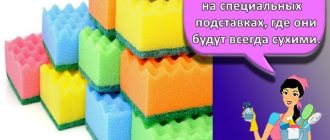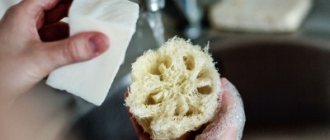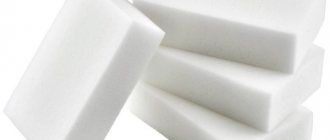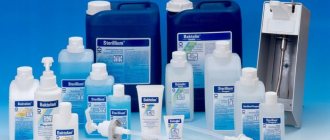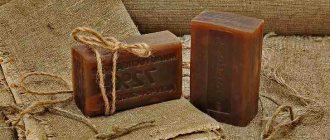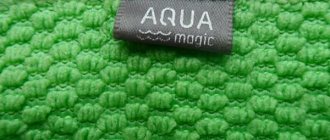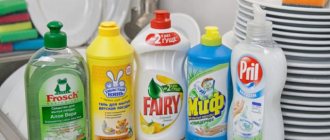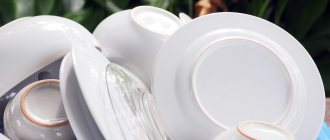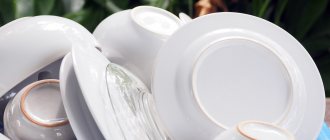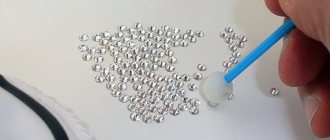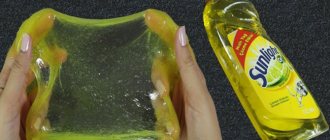Despite the fact that many modern kitchens are equipped with dishwashers, every housewife still buys sponges for washing dishes.
Considering how many varieties are now produced, you can get confused and make the wrong choice.
But a good sponge should not scratch thin glass, save time and make the dishwashing process easy, fast, and enjoyable.
Content
- How are dish sponges made?
- Types of products
- Classification by material
- Sizes, shapes
- How to determine quality
- How to store and use
- Rules of care
- How to make a laundry sponge yourself instead of using a store-bought sponge to wash dirty dishes
- Manufacturers and prices
- Tips and tricks
There are many types of household sponges that are designed to clean a particular surface.
Benefits and Features
The unique cleaning properties of sponges are due to the characteristics of the material covering them - melamine. It consists of crystals formed by the combination of ammonia and cyanochloride. The surface of the product when dry is rough and hard, resembling sandpaper to the touch. At the same time, the structure of melamine is different: it is fragile, porous, with a characteristic “glass” shine.
The standard sponge is rectangular in shape, sizes may vary. The color is white or any pastel. The composition is mixed: standard products have an inner layer of foam rubber or polypropylene and an outer layer of melamine. The cleaning properties of the sponge depend on the thickness of the top layer. More expensive options can be made entirely of melamine.
Melamine sponges are designed to clean stubborn stains: various stains, traces of rust, mold, grease, limescale stains. They cope with ink, lines left by markers and pens, stubborn dust, shoe soles, and all kinds of coloring liquids. Any surface can be processed: plastic, rubber, artificial and natural fabrics, leather, metal, ceramics.
Most often, products are used for laundering
- doors, window and door slopes;
- skirting boards;
- walls painted or covered with washable wallpaper;
- tiles and tile joints;
- floor coverings (linoleum, artificial stone, parquet, laminate);
- lint-free rugs;
- plumbing fixtures (bathtubs, shower trays, sinks, toilets);
- shoes (leather or fabric uppers, light-colored soles);
- upholstered furniture;
- outerwear made of natural or artificial leather;
- office equipment (phones, printers, computer cases and keyboards);
- car interiors, including mats and covers.
Sponges are not suitable for everyday cleaning; their purpose is to remove dirt that is stubborn or resistant to regular detergents. The products are multifunctional; there is no need to buy separate packaging for each specific problem. When used correctly, sponges are safe and non-toxic. They save detergents: for high-quality cleaning you only need warm water and a soft cloth for wiping.
How are dish sponges made?
To create such assistants for housewives, first a roll of fiber is taken, which is fixed on a special machine and tucked into unwinders. To understand what a dishwashing sponge is made of and consists of, you should imagine hot melt adhesive. It is applied to the prepared fiber, elastic polyurethane foam is attached here, after which the future workpiece is cut off and sent to a pneumatic press. All this ends with polymerization. Here's how and what dishwashing sponges are made of.
Sponges with yellow side
Sponges with a yellow side are considered the most gentle. Since this material has the softest rigidity, you can wash glasses and glassware with a sponge. The yellow side of the sponge will cope well with any dirt.
You can safely wash any surface with these sponges and not be afraid that they will leave scratches.
There are many other sponges with different colors of the rainbow, you shouldn’t pay attention to them, because they are just a simple dye, and in quality they are much inferior to all those described above, and they are worse for washing dishes.
You can also see melamine sponges on sale that will help you cope with any stains .
Subject:
- Life
Classification by material
Foam rubber experts of cleanliness are most often found in the kitchen of housewives. The material is porous, so it is enough to apply even a drop of detergent here and a sufficient amount of foam will form.
But what an abrasive sponge is made of is foam rubber, on the surface of which there is an abrasive coating. It looks like fine sandpaper. This layer will help cope not only with dirt on dishes, but also on the hob, on the sink, on household appliances, and on the bathtub. That's what an abrasive kitchen sponge is.
A microfiber washcloth is environmentally friendly; it gently washes dirty surfaces, but is not durable.
And the silicone sponge has a long service life; it can be used to clean even delicate objects. It does not absorb dirt and grease and is antibacterial.
Viscose is used for the production and manufacture of cellulose household sponges for washing dishes. It is environmentally friendly, hypoallergenic.
A plastic sponge can be used on a variety of surfaces, including those that need to be carefully cleaned.
The material chosen depends on where the sponges are used. Metal ones are made of thin wire. They are intended for washing complex stains and burnt food from durable surfaces. But this material is not intended to work with dishes made of enamel, ceramics, or Teflon, since the sponge is made from metal raw materials that scratch some surfaces.
Greenway Aquamagic wipes... and other high-quality microfiber wipes
Microfiber wipes from the “young” Greenway brand have won the love and respect of thousands of Russians. At least that’s what it would seem from the rave reviews on social networks and rave reviews of products on YouTube. In fairness, it is worth noting that Greenway is a network MLM company, and many owners of miracle rags made of unique microfiber are also their distributors.
Wipes under the Aquamagic brand really do an excellent job of removing various types of dirt without the help of cleaning agents. They instantly absorb moisture, scrub away dried-on dirt and attract dust thanks to the static tension created by friction.
Descriptions on online store websites say that Greenway Aquamagic napkins are made using Japanese technology from innovative ultra-thin dissected microfiber with special performance characteristics. In fact, behind the big words about innovation lies the classic and familiar microfiber, the production technology of which was actually invented by the Japanese - but not a few years ago, but back in 1976.
In essence, Greenway napkins are high-quality cleaning materials for cleaning for 250-600 rubles apiece, which differ from cheap microfiber cloths for 80-120 rubles in a much higher density (as a result - a longer service life and better absorbency).
What are the advantages of Greenway napkins:
► High absorbency;
► Durability and wear resistance;
► Wide range - the catalogs include single-sided and double-sided wipes with a smooth and rough structure, scrubber wipes for removing stubborn dirt, abrasive discs, sponges and mittens;
► Wipes for different surfaces – smooth for caring for monitors, glass, mirrors and glossy surfaces; large for car care; made of looped microfiber and ribbed for wiping dust; with a scrubbing side - to remove fatty deposits and other heavy contaminants.
High-quality microfiber cleaning materials are produced not only under the Greenway brand. Read the blog on how to choose and use microfiber cloths correctly.
Sizes, shapes
It is more advisable to buy a kitchen aid that fits in your hand. But for hard-to-reach places, it is sometimes more convenient to use small washcloths. Speaking about what other sizes of dishwashing sponges there are, it is worth noting that these are large. They can quickly wash even large surfaces. But the cleanliness attribute must be easy to use. In addition to the usual rectangular shape, a dish sponge can have the following shape:
- oval,
- square,
- curly,
- profile,
- with grip.
How to choose the best product
When choosing a sponge, you need to consider the following parameters:
- Manufacturer . Sponges of domestic and Chinese production are widely represented on the Russian market. Before purchasing, you need to make sure that the product is certified: this guarantees its safety.
- Compound . Products can consist of pure melamine or have a propylene base. The first option wears out faster and crumbles more often. Sponges with a base are more durable and more comfortable to hold in your hand.
- Size . Large, ergonomically shaped products are convenient for treating large surfaces (tiles, light floors, shower walls). Small sponges with pointed corners are good for removing spot marks, such as marker marks.
- Amount of foam when cleaning . Strongly foaming sponges cope well with stubborn dust, dirt, and grease. Products that work on the eraser principle produce almost no foam, but are good at removing various coloring components, limescale stains, and mold.
- Versatility . Beginners should try sponges suitable for any surface. If you need to remove particularly stubborn stains of a certain nature, it is better to look for products that can cope with this type of stain. The manufacturer must indicate this information in the instructions.
- Value for money . Most sponges fall into the mid-price category. Depending on the size and number of products in the package, the retail price ranges from 30 to 300 rubles.
How to determine quality
When deciding which sponges are best for washing dishes, you need to focus on:
- on the reliability of the manufacturer;
- efficiency and ease of use of the product;
- then whether small particles of abrasive material remain in the hand;
- no unpleasant odor;
- what surfaces the product is intended for cleaning.
Also, a sponge for washing dishes must comply with GOST, and if people who are prone to allergies buy it, then it is important to choose a product that does not lead to such reactions.
The best melamine sponges for shoes and clothes
Such sponges can be used not only for caring for clothes and shoes, but this is precisely the task they cope with best. We looked at 5 options with the most striking characteristics and chose from them one of the best melamine sponges based on customer reviews.
Ginger cat
The “Red Cat” melamine sponge is designed for the gentle removal of all types of dirt from various surfaces – wood, metal, fabric, glass, ceramic. According to the principle of use, it is similar to a stationery grater and when removing traces of grease, dust, rust, wool, it wears out in the same way, but this process can be slowed down by positioning the product at an angle during processing. The washcloth has almost no smell and is suitable for allergy sufferers. Its lack of a top layer makes it easy to clean hard-to-reach places.
Advantages
- Low price;
- Sold in 2 pieces. packaged;
- Rectangular shape;
- Lasts a long time;
- Does not contain additional components;
- Fast results.
Flaws
- Not detected.
How to store and use
The foam sponge needs to be renewed at least once a week. And if the washcloth is made of natural material, then once every 1 or 2 months.
Here's how to store a sponge for washing dishes; for this, use a soap dish, a specially purchased open container. Sometimes they place a wrung-out washcloth on the edge of the sink.
If you want to store a sponge for washing dishes in the kitchen so that it is not visible, then this item is dried to a slightly damp state and, after use, is put away in the cabinet under the sink.
Useful tips from manufacturers and consumers
Do you use melamine sponge?
Constantly! I want to try
It is prohibited to use sponges to wash the face, body, and paws of pets. Most manufacturers do not recommend washing dishes with sponges. The exception is persistent carbon deposits on the outer surface of frying pans and pots. Some brands offer special products for cleaning porcelain, glass, and grill grates. Such sponges are more durable, but after work you need to thoroughly rinse the surface. Doctors warn: the smallest particles of melamine that are not washed off can enter the body. As they accumulate, they settle in the kidneys and become the cause of urolithiasis.
People with allergies should take special care. Do not heat the sponge or rub it on hot surfaces. An increase in temperature will not only damage the product itself, but will also provoke the release of harmful fumes. Clean the stove burners, internal surfaces of the oven and microwave only if they are heavily soiled. A mandatory item is thorough rinsing with clean water.
Manufacturers do not recommend using melamine-coated products for cleaning shiny surfaces (for example, car enamel). Tiny abrasive particles can scratch paint and varnish. If you need to remove stubborn stains, you should try the sponge on an inconspicuous area.
To extend the life of the sponge, it is cut into several pieces and used until the melamine layer is completely abraded. Another way is to clean the dirt with a corner, and after abrading the top layer, simply cut off the unusable part. If the product no longer removes dirt, it should be replaced. You should not use a polypropylene base as a regular sponge; the remaining melamine particles will react with detergents.
After cleaning, the melamine sponge is rinsed and wrung out. The product must be dried in air: heating devices will ruin the structure of the material. Direct sunlight can destroy fragile melamine and the top layer will begin to crumble. You can store the product in any lockable box or jar, away from pets, children, and food. Some brands produce convenient plastic stands that will not only preserve the sponge, but also decorate the bathroom.
A melamine sponge is a reliable assistant that can quickly remove stubborn dirt, grease, rust and other unpleasant stains. The products are affordable, easy to use, and suitable for different surfaces. In order not to be disappointed in them, you should read the instructions before purchasing; reviews from experienced users will also help.
How to make a laundry sponge yourself instead of using a store-bought sponge to wash dirty dishes
To make such a kitchen accessory, you can use a vegetable net, jute or tulle. Thick, dense, unpainted foam rubber is also suitable. This kitchen accessory of the desired shape is cut out of it.
Here's how else you can replace a sponge for washing dishes: if you bought an onion in a net, then you need to fold it 4 times and tie it with a crochet hook. It will also be useful for creating a jute washbasin.
The secret of choosing the right one
Before you delve into the variety of brushes and sponges, it is important to understand your needs. Why, for example, does a housewife who primarily cooks in a multicooker with a non-stick coating need metal scrapers to remove a thick layer of fat from a cast-iron frying pan? Therefore, first of all, it is worth asking yourself a few questions:
- How many dishes do you have to wash daily? The answer to this question depends on many factors: how many people live in the apartment, whether all family members eat at home all the time, how many kitchen utensils are usually involved in the cooking process, how often you have to receive guests, etc.
- What kind of cookware is usually used, and what are the features of caring for it? Thus, Teflon and ceramics do not tolerate strong mechanical impact and abrasive substances, while cast iron products are resistant to such cleaning.
- What are the preferred cooking methods and favorite dishes of family members? Washing a pan after boiling or stewing vegetables usually does not require much effort, which cannot be said about cleaning the pan after cooking porridge, which often burns. Washing out a bowl of fruit salad is much easier than ridding a frying pan of grease after deep-frying potatoes.
Only after a thorough analysis of your needs can you choose from the whole variety of sponges and brushes exactly what you really need, and not succumb to the temptation to make a purchase just because the miracle thing was advertised by a practical housewife from YouTube. Now you can see what the manufacturers offer.
